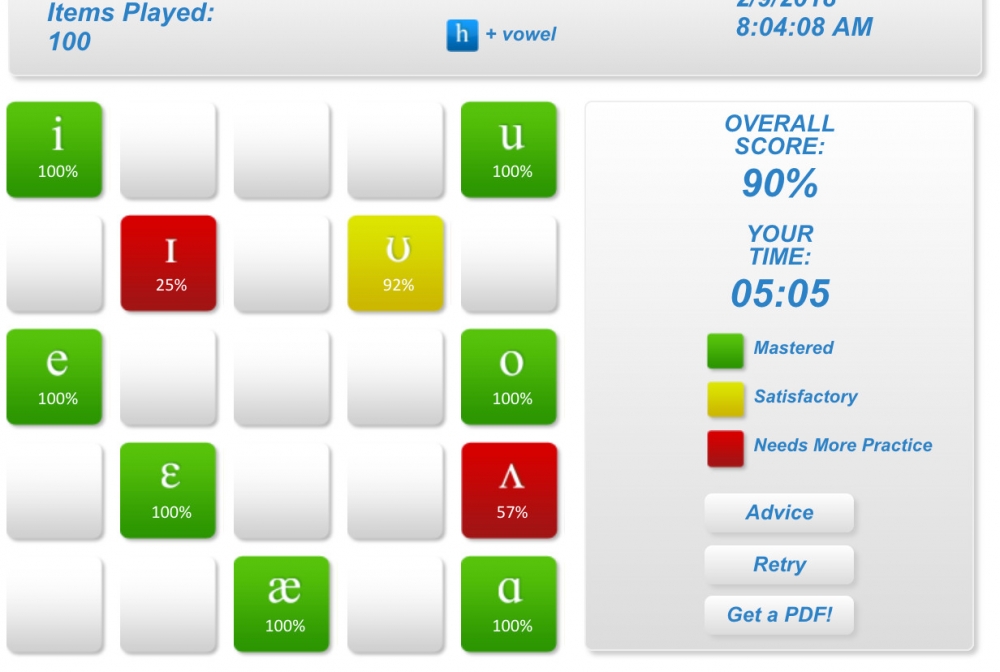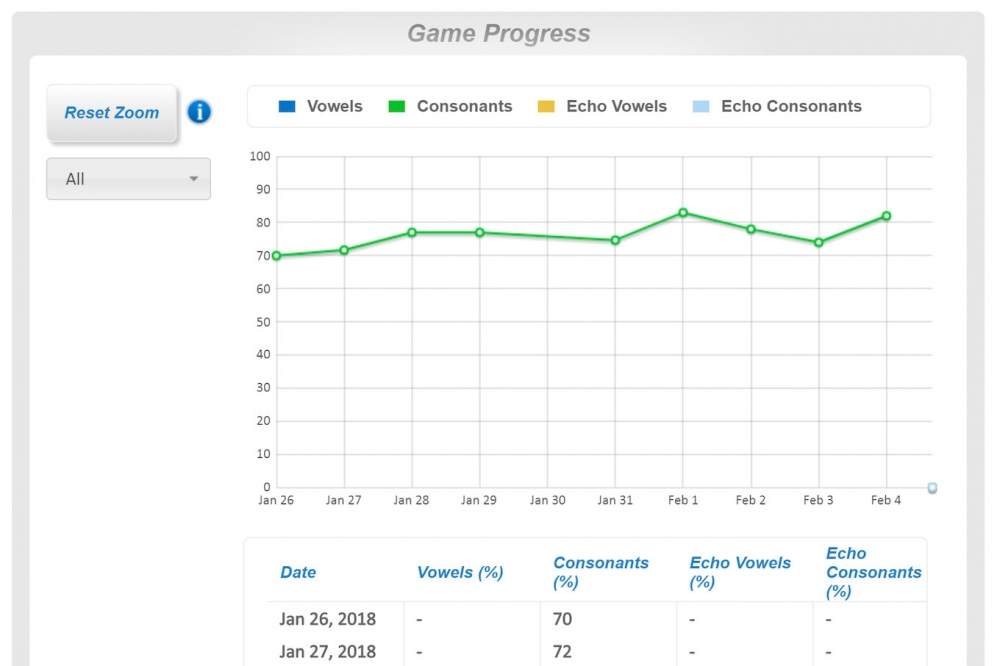|
English Accent Coach (EAC) is an online tool for pronunciation
created by Ron Thomson of Brock University in Ontario. It’s been online
since 2012, but I just began assigning it to my students this year. I
use the website
version. A subset of the functions is also available in an
iPhone app.
Using the EAC website, students can practice recognizing and
distinguishing English vowels and consonants. The site provides high
variability training with recordings of 30 voices (15 male and 15 female
speakers) pronouncing syllables and words. Users can play one of three
games using these recorded sounds: “Vowels” or “Consonants” in which
players click the sound they heard, or “Echo” in which players remember
increasingly long sequences of sounds. In each game, the user chooses
which phonemes to practice and the context in which they will hear the
selected sounds. This choice of context is expressed as the
“level”—Levels 1 through 3 are open syllables with increasing variation
in the additional phoneme. Higher levels place the target phoneme in
various positions within one- and two-syllable words.
Throughout the website, phonemes are identified by their IPA
symbols. The EAC website includes brief lessons about the phonemes and
their IPA symbols, which users can explore prior to playing the games,
if they wish. During the vowel game, users have the option to use colors
(as in the color vowel
chart) instead of IPA symbols.
The Vowel and Consonant games offer immediate feedback when the
user misidentifies a sound. A tone indicates the mistake, and a
correction is given—the user must acknowledge the correction by clicking
the right answer before he or she can proceed. At the end of each game,
the user receives a report card indicating his or her mastery level for
each sound, including a color code and the percent correctly identified
(see Figure 1).

Figure 1. Example of a report card indicating the mastery level of each sound.
Users can also track their progress over time, showing overall
scores for any or all games on a line graph. See Figure 2 for an example
graph showing student progress.

Figure 2. Screenshot of a “Your Progress” graph.
Click to enlarge.
I had the impression that EAC could be very useful as a
supplement to pronunciation lessons. It’s clearly not a substitute for a
pronunciation teacher, because it doesn’t provide productive practice
of phonemes or any instruction at all in suprasegmental features of
pronunciation. But the strength of EAC is that students can do
intensive, individualized work on the specific sounds they have trouble
with. This is a major advantage in an ESL context, with speakers of
several first languages in one class. For a few years, I’ve been
planning to use EAC as homework to supplement my classroom pronunciation
lessons, and this term I finally returned to the intensive English
program classroom after a few years of other assignments.
I’m teaching a speaking and discussion class to intermediate
level students whose first languages are Chinese, Japanese, and Spanish.
Pronunciation is one strand of the 40-hour curriculum (4 hours a week
for 10 weeks). I started with a speaking diagnostic that students
recorded in class. In my written feedback on the diagnostic, I commented
on suprasegmental features of pronunciation and other aspects of
speaking skills, and also on phonemes that seemed to pose a challenge
for each student, including screen captures from EAC showing the phoneme
selections I recommended that they practice. I showed students a brief
tour of the EAC website and asked them to sign up and practice regularly
according to their own interests and my recommendations. Each week
students send me a screen shot of the “Your Progress” graph as evidence
of their work. As you can see in the screen capture from one student
(Figure 2), even in quite a short time, I’ve seen evidence of
improvement!
During the first half of the term, I’m using all the class time
I can dedicate to pronunciation for lessons on suprasegmental features,
while students use EAC to work at home on phonemes. Meanwhile, my
students regularly record speech samples for a variety of purposes, so
I’m able to provide ongoing written feedback on their pronunciation,
including segmental aspects. I plan to spend a couple of lessons on
production of challenging phonemes a bit later in the term. So far
though, EAC is working well. Students willingly created accounts and use
the site several times a week.
If you haven’t already, you should have a look at the EAC
website. You can recommend it informally to your students, or use it for
homework to supplement your pronunciation instruction as I am doing
this year. I think it can be very helpful, especially if you have
students from a wide variety of language backgrounds, with different
phonemes challenging different students. Check it out!
Beth Sheppard is an ESL instructor at the
University of Oregon. She earned her bachelor’s degree in
interdisciplinary studies from UC Berkeley, and her MA in linguistics
from the University of Oregon. Beth teaches listening and speaking
skills and does online teacher training. She has also taught German and
Chinuk Wawa. | 
